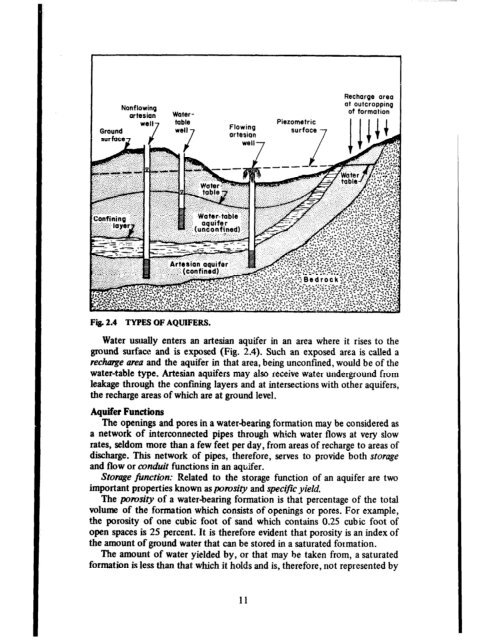Water Well Manual (USAID).pdf - The Water, Sanitation and Hygiene
Water Well Manual (USAID).pdf - The Water, Sanitation and Hygiene
Water Well Manual (USAID).pdf - The Water, Sanitation and Hygiene
You also want an ePaper? Increase the reach of your titles
YUMPU automatically turns print PDFs into web optimized ePapers that Google loves.
Ground<br />
surfuce7<br />
Nonflowing<br />
artesian<br />
Woter-<br />
Fig. 2.4 TYPES OF AQUIFERS.<br />
Flowing<br />
. .<br />
artesian<br />
Recharge area<br />
at autc?opping<br />
of formation<br />
<strong>Water</strong> usually enters an artesian aquifer in an area where it rises to the<br />
ground surface <strong>and</strong> is exposed (Fig. 2.4). Such an exposed area is called a<br />
rechmge area <strong>and</strong> the aquifer in that area, being unconfined, would be of the<br />
water-table type. Artesian aquifers may also receive water underground from<br />
leakage through the confining layers <strong>and</strong> at intersections with other aquifers,<br />
the recharge areas of which are at ground level.<br />
Aquifer Functions<br />
<strong>The</strong> openings <strong>and</strong> pores in a water-bearing formation may be considered as<br />
a network of interconnected pipes through which water flows at very slow<br />
rates, seldom more than a few feet per day, from areas of recharge to areas of<br />
discharge. This network of pipes, therefore, serves to provide both storage<br />
<strong>and</strong> flow or conduit functions in an aquifer.<br />
Stooge fin&on: Related to the storage function of an aquifer are two<br />
important properties known as porosity <strong>and</strong> specific yieZd.<br />
<strong>The</strong> porosiZy of a water-bearing formation is that percentage of the total<br />
volume of the formation which consists of openings or pores. For example,<br />
the porosity of one cubic foot of s<strong>and</strong> which contains 0.25 cubic foot of<br />
open spaces is 25 percent. It is therefore evident that porosity is an index of<br />
the amount of ground water that can be stored in a saturated formation.<br />
<strong>The</strong> amount of water yielded by, or that may be taken from, a saturated<br />
formation is less than that which it holds <strong>and</strong> is, therefore, not represented by<br />
11

















